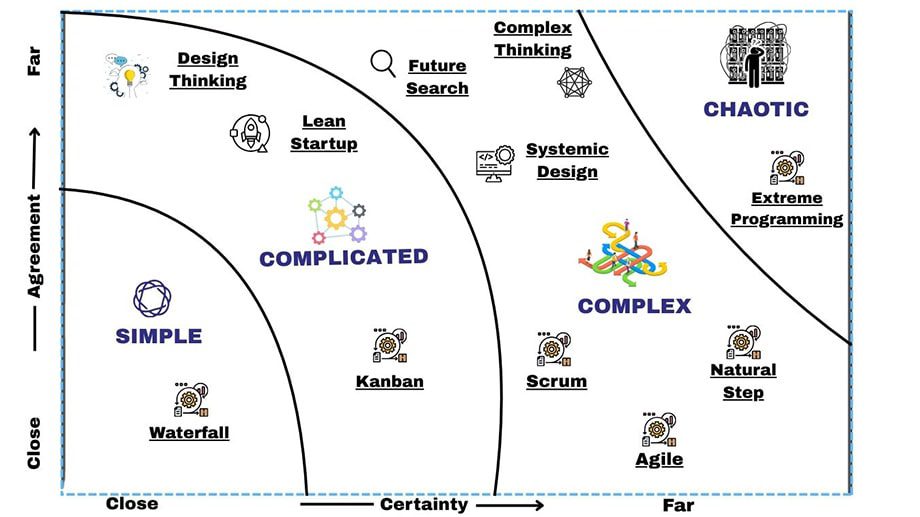The Misconception of Agile
Many teams claim they’re using Agile simply because they have stand-ups, follow sprints, or conduct retrospectives. However, Agile isn’t just a set of rituals—it’s a mindset, a cultural shift in how work gets done.
The real benefits of Agile emerge when the methodology is adopted holistically, rather than cherry-picking convenient elements. For instance, a company running two-week sprints but still requiring rigid sign-offs and extensive upfront planning isn’t truly Agile—it’s just doing “Waterfall in short bursts.”
The Word ‘Agile’ vs. Agile Methodology
The term “Agile” is often misunderstood. While it literally means being nimble and adaptable, Agile as a methodology follows structured frameworks designed to enable adaptability efficiently.
Simply being responsive doesn’t mean a company follows Agile principles. In fact, many successful companies thrive using other methodologies. Here are a few notable examples:
- Tesla: Uses a structured, engineering-first approach rather than Agile sprints. Their innovation comes from a tightly controlled, top-down strategy rather than iterative feedback loops.
- Airbus & Boeing: The aviation industry demands precision and compliance. Moving fast and breaking things isn’t an option, making Agile a poor fit.
- Berkshire Hathaway: Warren Buffett’s investment firm focuses on long-term, data-driven decision-making, which contrasts with Agile’s rapid iterations.
These examples show that Agile isn’t a one-size-fits-all solution. Other methodologies like Waterfall, Kanban, or Hybrid approaches might be better suited depending on the project type.
When Agile Works—and When It Doesn’t
Agile thrives in environments where rapid iteration, flexibility, and continuous learning are necessary. However, it’s not always the best choice. Here’s a breakdown:
Where Agile Works Best:
- Software development: When requirements evolve frequently, Agile allows for adaptability and continuous improvements.
- Product innovation: Encourages rapid prototyping and user feedback to refine products quickly.
- Startups and experimental projects: Businesses testing new ideas can pivot quickly using Agile.
Where Agile May Not Be Ideal:
- Large-scale infrastructure projects: Require strict compliance, risk management, and long-term planning.
- Industries with high precision needs: Aerospace, healthcare, and construction often need detailed specifications upfront.
- Financial and investment firms: Long-term strategies don’t align well with Agile’s iterative nature.
This is where the Stacey Matrix helps businesses determine which methodology-Agile, Kanban, Waterfall, or a hybrid—is best suited for their project.
Introducing the Stacey Matrix for Methodology Selection
The Stacey Matrix is a decision-making framework that categorizes projects based on two factors:
- Requirements Certainty: How well-defined and stable the project requirements are.
- Technical Complexity: The level of complexity and uncertainty involved in execution.
How the Stacey Matrix Works:
- Simple Projects: Clear requirements and low complexity → Waterfall or traditional project management works best.
- Complicated Projects: Defined requirements but high complexity → Kanban or Lean methodologies work well.
- Complex Projects: Uncertain requirements and high complexity → Agile (Scrum, SAFe) is the best approach.
- Chaotic Projects: Constantly shifting requirements with no clear path → Extreme programming (XP) or crisis management techniques are necessary.
In Complex Projects, where Agile is recommended, collaboration, feedback loops, and iteration become essential. Decision-making is based on dialogue and debate rather than rigid planning (correcting the earlier AI typo).
Is Your Team Using the Right Methodology?
Many teams claim to be Agile but only adopt a few elements without fully embracing its principles. Agile is about collaboration, adaptability, and customer-centricity—not just running sprints and stand-ups.
Understanding where your project falls on the Stacey Matrix can help you determine the right methodology—be it Agile, Kanban, Waterfall, or a hybrid approach.
So, is your team truly Agile—or just borrowing a few elements? It’s time to step back, evaluate your approach, and ensure that your methodology aligns with your project goals.
